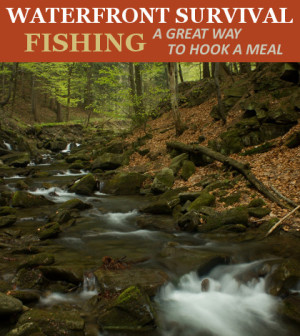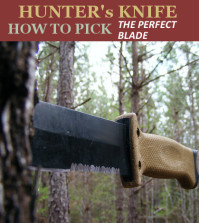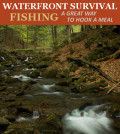Waterfront Survival: Fishing Is the Easiest Way To Hook a Meal For Survival

Fishing is perhaps the cheapest, easiest, and safest method of acquiring a meal during a survival scenario.
How so?
Say for instance, you are backpacking through lands of Southeast Asia, admiring its gorgeous dynamic landscape –when something happens that throws you into a nasty situation.
Whether it was a storm, a brush with criminals, or even an accident that placed you there –you are far from home, likely injured, tired, lost, hungry, and very, very stressed out. You are now in backwoods, and your only option is to survive until you are found or drag yourself out. Though you can stay alive for 3 weeks without a meal, your body slows down after just 72 hours –and lethargy can take its toll.
Depending on what was in your pack (or even if you had a pack in the first place), it is likely that you had a fishing kit on hand. Why? Even rather comprehensive kits can fit in a cargo pants pocket …which brings us to the first reason that fishing is the easiest way to hook a meal in a survival situation.
#1: Because fishing kits are compact.
You probably remember your grandpa’s old tackle box. It was loaded with bobbers, hooks, jigs, flies, weights, an old sandwich wrapper, and a small foam container of live bait from 1992… and those worms are probably still alive from feeding off the stink bait sitting right next to it.
While this setup works wonderfully on the shore of some cozy river, your kit doesn’t need to be a tenth that size.
In fact, you can get away with the following:
- Small assortment of hooks –You can catch a big fish on a small hook, but you can’t catch a small fish on a big hook.
- 100 yards of 6lb-test monofilament – Basically a good all-around strength for fishing line.
- Weights of assorted sizes – Because you just don’t know what the current will be like.
- Small bobbers – If it’s simple enough to work for a 5-year-old, then it’s simple enough for a survival situation. Even a cork will do well.
- Lures (optional) – They’re great if you know how to use them and what you’re fishing for.
- Safety pins – These will allow you to fix rings on an improvised rod, making fishing a heck of a lot easier and more effective.
- Trot line – We’ll get to this later.
- Fishing yo-yos – We’ll also get to this later.
- 2-3 large hooks – For catching those gut-filling big ones.
With the exception of the fishing yo-yos, that entire system can fit into a Tazo Tea tin box and will catch anything from panfish to bass to cats.
Of course, your pack should have a sturdy survival knife and a multitool. If this weren’t a survival scenario, I’d say a cheap fishing fillet knife would do the trick –but because weight and utility go hand-in-hand during difficult times such as these, then it is best to buy yourself a no-nonsense, hi-carbon, full-tang, drop point blade, that is no more than 4 inches in length; mtech has some fine collection. Not only can you chop limbs off trees for firewood and shelter with a blade like this, but you can also process the day’s catch if you brought a cheap retractable diamond rod sharpener. You’re not looking for chef-style cuts here… it doesn’t have to be pretty.
Your multi-tool is also key, because they have several tooling options that will make your survival fishing venture much easier. From removing and even sharpening hooks to having an additional blade for processing your trout. Oh, by the way, they can perform a truckload of other survival tasks; which, makes a packing multi-tool a no-brainer.
#2: Because, if anything, you want to be near the water.
There’s a reason why most of the world’s oldest cities are situated near bodies of water. Whether rivers, oceans, lakes, or streams… bodies of water are nothing but wonderful pools, overflowing with resources and opportunities. They were integral in being used for transportation, commerce, food sources, and of course, the water itself.
In your situation, the water is your own ‘sea’ of opportunity, as it provides you with several advantages:
- First, you won’t run out of water. Obviously this is the case, but the truth remains: you don’t want to run out of water in a survival situation! Be sure to boil, and drink responsibly.
- Second, situating yourself near the water will make you more visible to search and rescue teams, and it may also place you in a spot that will likely be trafficked by the locals. In addition, a beach is often an area of exposure that can be seen for miles (depending on the geography, of course), and sound carries very far over water.
- Third, you’ve placed yourself smack in a location that will allow you to fish. But you don’t only have to stop with fishing! Critters of all shapes and sizes congregate at the waters edge, providing you with a better chance of taking a mammal… a tasty, tasty mammal.
#3: Because you can fish… without actually fishing.
Economics is merely the study of survival in civility –and any good economist will tell you that time is your most valuable resource, because it can never be replaced. This is why the world’s wealthiest people have learned to leverage their time by setting up systems that will allow them to do many things at once.
How can this principle be applied to fishing for survival?
Using the right fishing methods will allow you to leverage your time (and thus, energy) because you can fish… without being in an active state of fishing.
Through the use of trot-lines and fishing yo-yos, you can catch a fish, while building shelter, sleeping, eating, building fire, boiling water, or whatever your still-beating heart desires. Here’s how:
- Worms, night crawlers, bugs, etc., can be found pretty much anywhere (apparently even cockroaches can live in space!) Dig, snatch, catch, scrape, do what you have to do… just get some kind of bait that a fish will find irresistible, and get that bad boy on your hook.
- Second, use your fishing kit to snag just about anything the fancies a nibble on your bait. Once you see that bobber bobbing… set the hook and bring it in.
- Third, depending on the size of your first catch, you can use the whole fish (if it’s small) or cut it up into chunks.
- Fourth, here are links on tutorials for running trotlines and using fishing yo-yos. Then all you need to do is get your bait on those larger hooks… and go take care of your other camp chores.
- Last, check your trotline or yo-yo. These have higher catch-probabilities than even body-grip traps for land animals, so you’re probably going to drag in a hefty catfish, carp, bass, or something that is large and very hungry.
Simply process, cook, eat, and feel happy that you caught a wonderfully nutritious, large (and quite tasty) meal… while you weren’t even fishing.
The principle was simple. You could’ve eaten the worm, but used it as bait for something bigger. You could’ve eaten your first catch, but used it as bait for something bigger. And as a reward for a little ingenuity, patience, and harnessing the power of economics-in-motion… dinner was satisfying and filling.
Not bad for a pocket-sized fishing kit. As usual, Usman (contributor) recommends that, it is best to pack thoughtfully. Remember to grab your first aid kit, knives, survival kit, and camping accessories when planing to go on an adventurous trip. You never know when you will be stuck in a situation where you will need to rely on the items in your backpack.





